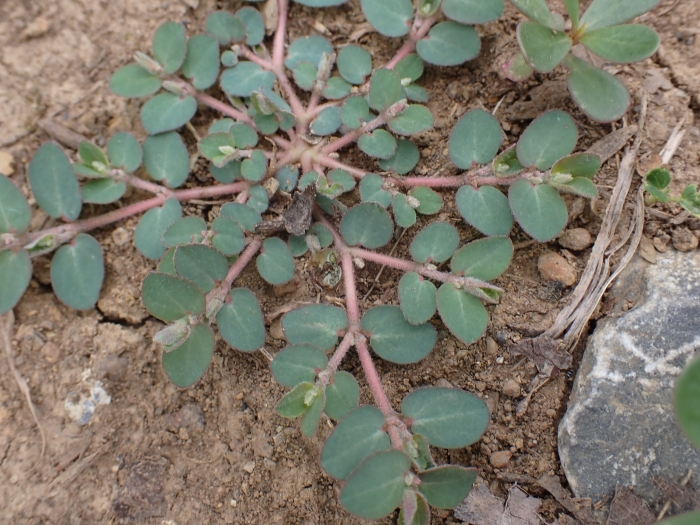Prostrate Spurge
(Euphorbia prostrata)
Prostrate Spurge (Euphorbia prostrata)
/
/

Cole Shoemaker
CC BY 4.0
Image By:
Cole Shoemaker
Recorded By:
Copyright:
CC BY 4.0
Copyright Notice:
Photo by: Cole Shoemaker | License Type: CC BY 4.0 | License URL: http://creativecommons.org/licenses/by/4.0/ | Rights Holder: Cole Shoemaker | Publisher: iNaturalist | Date Created: 2021-08-12T16:09Z |
























Estimated Native Range
Summary
Euphorbia prostrata, commonly known as prostrate spurge or prostrate sandmat, is an annual herb originally native to tropical and subtropical regions of the Americas, including the Caribbean and parts of South America. It is adapted to a variety of habitats, including open areas, disturbed sites, and roadsides. Typically, it has slender, prostrate stems that can grow up to 8 inches long, with oval-shaped leaves that have finely toothed edges. The plant produces small, inconspicuous white cyathium flowers throughout the growing season. While not particularly showy, the flowers are characteristic of the Euphorbiaceae family.
Prostrate spurge is known for its rapid growth and ability to cover ground quickly, making it useful as a temporary ground cover in warm climates. However, it is also considered a weed in many regions due to its invasive nature. It thrives in full sun to partial shade and prefers well-drained soils but can tolerate a range of soil types and conditions. In cultivation, it requires minimal care and is drought-tolerant once established. Gardeners should be cautious, as the plant can become invasive outside its native range, and its milky sap may cause skin irritation or allergic reactions.CC BY-SA 4.0
Prostrate spurge is known for its rapid growth and ability to cover ground quickly, making it useful as a temporary ground cover in warm climates. However, it is also considered a weed in many regions due to its invasive nature. It thrives in full sun to partial shade and prefers well-drained soils but can tolerate a range of soil types and conditions. In cultivation, it requires minimal care and is drought-tolerant once established. Gardeners should be cautious, as the plant can become invasive outside its native range, and its milky sap may cause skin irritation or allergic reactions.CC BY-SA 4.0
Plant Description
- Plant Type: Herb
- Height: 0.1-0.2 feet
- Width: 0.5-1 feet
- Growth Rate: Rapid
- Flower Color: Green, Pink, Red
- Flowering Season: Spring, Summer, Fall
- Leaf Retention:
Growth Requirements
- Sun: Full Sun
- Water: Medium
- Drainage: Medium, Fast
Common Uses
Groundcover, Low Maintenance
Natural Habitat
Originally native to tropical and subtropical regions of the Americas
Other Names
Common Names: Prostrate Spurge, Blue Weed, Ground Spurge, Yerba Di Lechi, Creeping Spurge
Scientific Names: , Euphorbia prostrata, Anisophyllum prostratum, Aplarina prostrata, Chamaesyce malaca, Chamaesyce prostrata, Chamaesyce villosior, Euphorbia callitrichoides, Euphorbia malaca, Euphorbia perforata
GBIF Accepted Name: